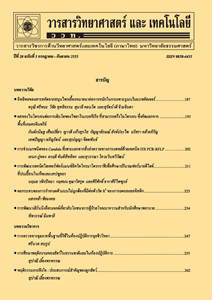สูตรที่เหมาะสมของการผลิตแก่นตะวันดองและกิมจิจากแก่นตะวัน
Main Article Content
Abstract
The purposes of this research were to study the effect of sugar content on the quality of pickled Jerusalem artichokes, and to study the optimum ratio of Chinese cabbage and Jerusalem artichokes on the quality of kimchi products. Physical properties and sensory evaluation of products were investigated. The results showed that weight loss value of Jerusalem artichokes varied directly with the amount of sugar. In addition, the hardness and lightness of Jerusalem artichokes were inversely with the amount of sugar. Apparently, the optimum sugar content was 40 g per 100 g of fresh Jerusalem artichokes. Interestingly, it had the highest overall liking score of kimchi products. In terms of kimchi products, pH and hardness of kimchi varied directly with the amount of Jerusalem artichokes, but weight loss value and lightness of kimchi were inversely affected by the amount of Jerusalem artichokes. The optimum ratio of Chinese cabbage and Jerusalem artichokes was 75:25 percent that had the highest overall liking score. Obviously, overall liking scores were considered. The results revealed that the overall liking scores from consumers on pickler and kimchi from peeling Jerusalem artichokes more than that from not peeled. Therefore, fresh Jerusalem artichokes can be feasibly processed into pickled Jerusalem artichokes and kimchi products. This will help to promote more widespread consumption. Furthermore, it also responds to the lifestyle of modern consumers.
Article Details
References
Pewsa-ard, J. and Seephaya, C., Jerusalem artichoke, Available Source: https://www.dss.go.th/images/st-article/sti-2-2558-SunChoke.pdf, November 25, 2018. (in Thai)
Puakrai, M., Puthorm, S., Techawongsatien, S. and Jogloy, S., 2013, Effects of temperature and packaging ventilation on quality of Jerusalem artichoke (Helianthus tuberosus L.) tuber, Khon Kaen Agric. J. 41(1)(Suppl.): 597-601. (in Thai)
Malai, D., Chaichawalit, C., Janphen, S. and Mailaead, S., 2013, Development of fresh noodles by substitution of Jerusalem artichoke powder, Agric. Sci. J. 22(2)(Suppl.): 269-272. (in Thai)
Tanjor, S., Judprasong, K., Chaito, C. and Jogloy, S. 2012, Inulin and fructooligo sacharides in different varieties of Jerusalem artichoke (Helianthus tuberosus L.), KKU Res. J. 17(1): 25-34. (in Thai)
Suphamityotin, P., 2013, Fruit and Vegetable Technology, Bangkok, Odeon Store, 280 p. (in Thai)
Puttha, R., Jogloy, S., Wangsomnuk, P.P., Srijaranai, S., Kesmala, T. and Patanothai, A., 2012, Genotypic variability and genotype by environment interactions for inulin content of Jerusalem artichoke germplasm, Euphytica 183: 119-131.
Duncan, D.B., 1995, Multiple range and multiple F-tests, Biometrics 11: 1-42.
Khamchu, W. and Yuenyongputtakal, W., 2007, Effect of sucrose and NaCl on mass transfer during osmotic treatment of muskmelon (Cucumis melo L.), Agric. Sci. J. 38(6)(Suppl.): 91-94. (in Thai)
Yuenyongputtakal, W., 2013, Factors influencing on dewatering by osmotic dehydration of fruits and vegetables, Burapha Sci. 18(1): 226-233. (in Thai)
Rattanapanone, N., 2014, Food Chemistry, Bangkok, Odeon Store, 504 p. (in Thai)
Pornchaloempong, P. and Rattanapanone, N., Pickle, Available Source: https://www.foodnetworksolution.com, November 25, 2018. (in Thai)
Neeha, V.S. and Kakade, S.B., 2014, Use of hurdle technology in food preservation, Int. J. Eng. Man. Res. 4(5): 204-212
Ziyan, E. and Pekyardimci, S., 2003, Charac terization of polyphenol oxidase from Jerusalem Artichoke (Helianthus tuberosus). Turk. J. Chem. 27: 217-225.


